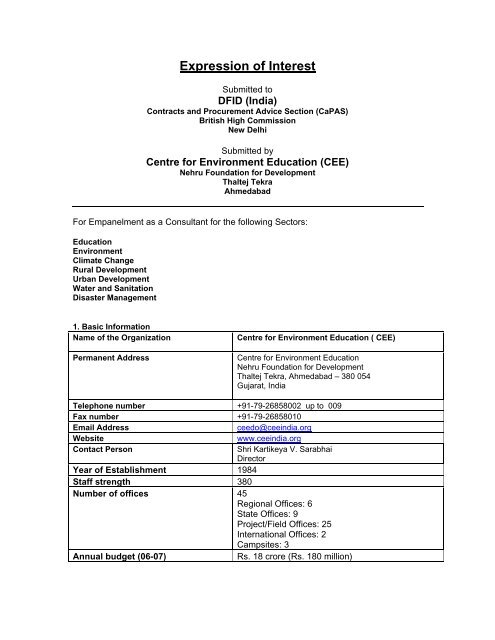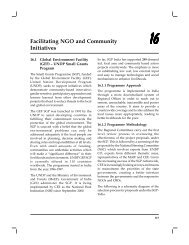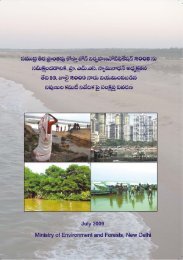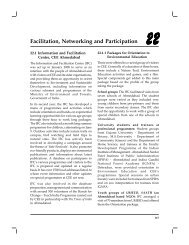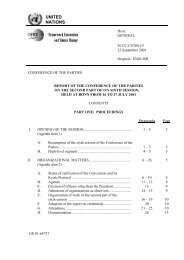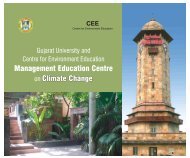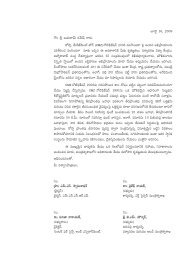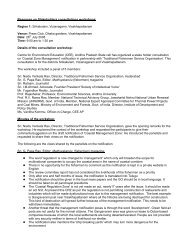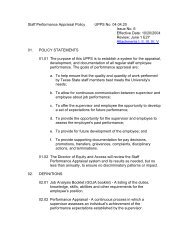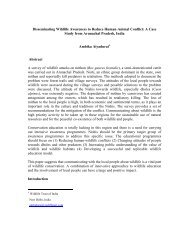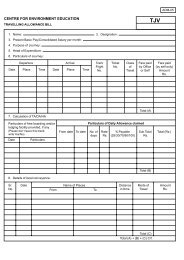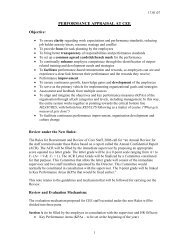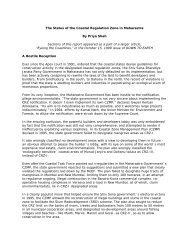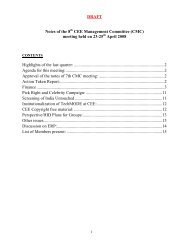Expression of Interest submitted to DFID for empanelment as ...
Expression of Interest submitted to DFID for empanelment as ...
Expression of Interest submitted to DFID for empanelment as ...
- No tags were found...
Create successful ePaper yourself
Turn your PDF publications into a flip-book with our unique Google optimized e-Paper software.
<strong>Expression</strong> <strong>of</strong> <strong>Interest</strong>Submitted <strong>to</strong><strong>DFID</strong> (India)Contracts and Procurement Advice Section (CaPAS)British High CommissionNew DelhiSubmitted byCentre <strong>for</strong> Environment Education (CEE)Nehru Foundation <strong>for</strong> DevelopmentThaltej TekraAhmedabadFor Empanelment <strong>as</strong> a Consultant <strong>for</strong> the following Sec<strong>to</strong>rs:EducationEnvironmentClimate ChangeRural DevelopmentUrban DevelopmentWater and SanitationDis<strong>as</strong>ter Management1. B<strong>as</strong>ic In<strong>for</strong>mationName <strong>of</strong> the OrganizationPermanent AddressCentre <strong>for</strong> Environment Education ( CEE)Centre <strong>for</strong> Environment EducationNehru Foundation <strong>for</strong> DevelopmentThaltej Tekra, Ahmedabad – 380 054Gujarat, IndiaTelephone number +91-79-26858002 up <strong>to</strong> 009Fax number +91-79-26858010Email Addressceedo@ceeindia.orgWebsitewww.ceeindia.orgContact PersonShri Kartikeya V. SarabhaiDirec<strong>to</strong>rYear <strong>of</strong> Establishment 1984Staff strength 380Number <strong>of</strong> <strong>of</strong>fices 45Regional Offices: 6State Offices: 9Project/Field Offices: 25International Offices: 2Campsites: 3Annual budget (06-07)Rs. 18 crore (Rs. 180 million)
1. Education <strong>for</strong> Children2. EE in Higher Education3. Examination Systems <strong>for</strong> EE4. Education <strong>for</strong> Youth5. Communicating Environment through the Media6. Experiencing Nature7. EE through Interpretation8. Knowledge Management <strong>for</strong> Sustainable Development9. Industry Initiatives10. Sustainable Rural Development11. Water and Sanitation12. Sustainable Urban Development13. W<strong>as</strong>te Management14. EE <strong>for</strong> Fragile Are<strong>as</strong>15. Biodiversity Conservation16. Eco-<strong>to</strong>urism17. Dis<strong>as</strong>ter Preparedness and Rehabilitation18. Training, Networking and Capacity Building19. Facilitating NGO and Community Initiatives20. Initiatives <strong>for</strong> the UN Decade <strong>of</strong> Education <strong>for</strong> Sustainable Development21. Research in EE6. Education <strong>for</strong> Sustainable Development: CEE’s Approaches and ExperiencesA core <strong>of</strong> ide<strong>as</strong>, concepts and strategies <strong>for</strong>ms the genesis <strong>of</strong> many <strong>of</strong> the initiatives <strong>of</strong> theCentre.CEE’s approaches and experiences <strong>to</strong>wards its core mandate <strong>of</strong> education <strong>for</strong> sustainabledevelopment are summarized in the three major inter-linked spheres – Education and Capacitybuilding,Policy Links, and Field-b<strong>as</strong>ed Demonstration projects <strong>to</strong>wards SustainableDevelopment. Each h<strong>as</strong> an overlap with the other, and hence, feeds in<strong>to</strong> the others.3
<strong>as</strong>ed higher education and are unique <strong>to</strong> the state <strong>of</strong> Gujarat. As part<strong>of</strong> this project, CEE h<strong>as</strong> worked closely with three RHEIs situated indifferent geophysical conditions <strong>to</strong> evolve a methodology <strong>for</strong> RHEIs.Major activities include capacity building <strong>of</strong> faculty and students inenvironmental education and sustainable natural resource managementpractices, infusion <strong>of</strong> environmental perspectives in<strong>to</strong> the curricula <strong>of</strong>three Gram Vidhyapiths, conducting micro-projects at the adopted 15villages <strong>to</strong> demonstrated sustainable livelihood practices in rural are<strong>as</strong>,etc.B. EnvironmentNo Title <strong>of</strong> the project Brief Description11. Ecodevelopment SitesEvaluation Study (1997)CEE w<strong>as</strong> the consultant <strong>to</strong> the Ministry <strong>of</strong> environment and Forests <strong>for</strong>the ecodevelopment sites evaluation study. The main t<strong>as</strong>k under theproject w<strong>as</strong>- identification <strong>of</strong> ecodevelopment evaluation parameters and <strong>for</strong>mats- discussion and consultation with respective <strong>of</strong>ficer-in-charge <strong>of</strong> theeco-site- collection <strong>of</strong> data/in<strong>for</strong>mation through meetings with <strong>for</strong>est <strong>of</strong>ficials,communities, other related government departments and NGOs- compilation and analyse the data/in<strong>for</strong>mation- site specific evaluation findings, recommendations, etc.Evaluation <strong>of</strong> the ecodevelopment projects implemented by the ForestDepartment around six protected are<strong>as</strong> across the country w<strong>as</strong> done byCEE and the report w<strong>as</strong> <strong>submitted</strong> <strong>to</strong> the Ministry.12. Conservation EducationStrategy and Action Planand InterpretationProgramme <strong>for</strong> 4 ProtectedAre<strong>as</strong> <strong>of</strong> Madhya Pradesh(1999-2000)13. Education, Awareness &Training Strategy andAction Plan <strong>as</strong> part <strong>of</strong> theNational BiodiversityStrategy and Action Plan(NBSAP)(2000-2003)14. Darwin Initiative(1997-2000)This project w<strong>as</strong> supported by the Madhya Pradesh <strong>for</strong>est departmentand included In<strong>for</strong>mation/data collection and analysis, training,workshop, evaluation, capacity building, meetings, designing, conceptdevelopment, research, setting up interpretation centers. The main t<strong>as</strong>kunder the project were- collection and analysis <strong>of</strong> in<strong>for</strong>mation on existing conservationeducation (CE) programmes, CE capabilities <strong>of</strong> Forest Department,NGOs, individuals, socio-eco-cultural and community- documentation <strong>of</strong> local people's own communication media andmethods- identification <strong>of</strong> local issues <strong>of</strong> protection, livelihood andenvironment- evaluation <strong>of</strong> institutional capabilities <strong>of</strong> EE- meetings, workshops with stake holders- identification <strong>of</strong> target groups and developing target group pr<strong>of</strong>ile- development <strong>of</strong> EE strategy and action plan- development <strong>of</strong> an outline <strong>for</strong> site specific interpretive plan <strong>for</strong> PAwith exhibits, nature trails, signages, wayside exhibits, publication,training programme <strong>for</strong> boatmen and guides.The National Biodiversity Strategy and Action Plan (NBSAP) is a projectsupported by the Ministry <strong>of</strong> Environment and Forests funded by UnitedNations Development Programme. NBSAP aims <strong>to</strong> produce a series <strong>of</strong>planning documents dealing with the conservation <strong>of</strong> India’s biodiversity,sustainable use <strong>of</strong> its biological resources, and equity including indecisions regarding access <strong>to</strong> such resources and the benefits accruingfrom them. As part <strong>of</strong> the NBSAP, CEE developed the Education,Awareness & Training Strategy and Action Plan.Conserving India’s Biodiversity through NGO training and Projects withLocal Communities: In collaboration with Field Studies Council, UK,8
CEE h<strong>as</strong> worked on a project “Conserving India’s Biodiversity throughNGO Training and Projects with Local Communities”. This project w<strong>as</strong>supported by the Department <strong>of</strong> Environment, Government <strong>of</strong> UK underthe Darwin Initiative. The objectives were <strong>to</strong> build the capacity <strong>of</strong> localNGOs in biodiversity conservation, equip them with the latest andupdated in<strong>for</strong>mation and data on biodiversity related <strong>as</strong>pects and helpthem in developing and effectively managing community projects.C. Climate ChangeNo Title <strong>of</strong> the project Brief Description15. Country Strategy <strong>for</strong> ODSPh<strong>as</strong>e Out (2003)CEE h<strong>as</strong> been involved in developing a comprehensive strategy <strong>for</strong>awareness generation <strong>as</strong> part <strong>of</strong> India’s country programme <strong>for</strong> ph<strong>as</strong>ingout ODS in collaboration with the Ozone Action Office <strong>of</strong> UNEP-Paris.The strategy which covers a 7-year period w<strong>as</strong> accepted by the OzoneAction <strong>of</strong>fice in <strong>to</strong><strong>to</strong>. The strategy targets refrigeration and airconditioning servicing sec<strong>to</strong>r <strong>as</strong> an important component <strong>to</strong> addressODS ph<strong>as</strong>e out in India.16. IEC Strategy <strong>to</strong> StrengthenCompliance with theMontreal Pro<strong>to</strong>col(2005-2006)17. Cleaner Production andEnergy Efficiency(2002-2003)18. Climate change andEnergy Scoping Study(2004)19. Climate change andadaptation issues in SouthAsia (2006 and continuing)The UNEP-Regional Office <strong>of</strong> Asia and the Pacific h<strong>as</strong> entrusted <strong>to</strong> CEEthe t<strong>as</strong>k <strong>of</strong> is implementing an integrated in<strong>for</strong>mation, education andcommunication (IEC) strategy <strong>to</strong> strengthen compliance with theMontreal Pro<strong>to</strong>col on substances that deplete the Ozone Layer in 24countries in South, South-e<strong>as</strong>t Asia and Pacific regions. The main t<strong>as</strong>ksbeing carried out are:- Developing an integrated datab<strong>as</strong>e <strong>of</strong> awareness materials producedin the 24 countries <strong>to</strong> help e<strong>as</strong>y and rapid adaptation <strong>for</strong> the benefit <strong>of</strong>each other, avoiding duplications <strong>of</strong> ef<strong>for</strong>ts in compiling anddisseminating in<strong>for</strong>mation.- Capacitating about 30-40 media persons <strong>to</strong> the issues whichdetermine the degree <strong>of</strong> compliance, and developing a networkinvolving them, <strong>to</strong> facilitate periodic publication on country-specificcompliance issues in local media.- Developing comprehensive IEC strategies that identify opportunities<strong>for</strong> augmenting in<strong>for</strong>mation support activities with financial andtechnical support <strong>to</strong> be derived from sources other than theMultilateral Fund.The project aimed at implementing energy efficiency and cleanerproduction me<strong>as</strong>ures <strong>to</strong> reduce carbon dioxide emission reduction in acluster <strong>of</strong> small scale industries across different sec<strong>to</strong>rs funded byUNDP / SGP.A framework <strong>for</strong> providing appropriate in<strong>for</strong>mation in timely manner onmitigation options, equity issues and co-benefits, w<strong>as</strong> evolved <strong>as</strong> part <strong>of</strong>a prepara<strong>to</strong>ry process <strong>of</strong> the British High Commission. This w<strong>as</strong> inresponse <strong>to</strong> improve the technical preparedness <strong>of</strong> industry, financialinstitutions, media and the representatives <strong>of</strong> the civil society <strong>to</strong> theemerging dynamics <strong>of</strong> market opportunities vis-a-vis climate changemitigation.Development <strong>of</strong> the decision support system <strong>for</strong> improvingpreparedness <strong>of</strong> concerned stakeholders on 'adaptation' imperativeswith respect <strong>to</strong> climate change. This initiative is supported by SDC andSACEP.9
D. Rural DevelopmentNo Title <strong>of</strong> the project Brief Description20. Communication support <strong>for</strong>Participa<strong>to</strong>ry ForestManagement in HimachalPradesh Forestry Project(1998-1999)CEE provided the consultancy services <strong>to</strong> the Department <strong>for</strong>International Development (<strong>DFID</strong>), UK, under the Himachal PradeshForestry Project. The main t<strong>as</strong>k under the project w<strong>as</strong> <strong>to</strong> identify andanalyse the various communication problem and issues, <strong>to</strong> helpprioritise the target audiences and media style appropriate <strong>to</strong> the targetgroup, <strong>to</strong> identify different communication media, <strong>to</strong> identify resourcepeople and institutes able <strong>to</strong> <strong>as</strong>sist the project21. RanthambhoreEcodevelopmentProgarmme (REDpro)(1988-2001)22. HingolgadhEcodevelopmentProgramme (HEDpro)(1988 and continuing)23. GRAM-NIDHI – EcoEnterprises <strong>for</strong> SustainableLivelihoods(1994-1995)24. Consultancy services andimplementation <strong>of</strong> Microplanningunder the U. P.Forestry Project(1999-2004)25. Andhra Pradesh DistrictPoverty AlleviationInitiatives Project(2003 and continuing)This w<strong>as</strong> the first programme taken up by CEE <strong>as</strong> a part <strong>of</strong> its ef<strong>for</strong>t <strong>to</strong>develop communication programmes <strong>for</strong> ecodevelopment. The projectw<strong>as</strong> implemented in selected villages around the RanthambhoreNational Park. The objective <strong>of</strong> the programme w<strong>as</strong> <strong>to</strong> find ways andmeans by which dependence on the resources <strong>of</strong> the <strong>for</strong>est could bereduced substantially so that incre<strong>as</strong>ed demand pressure due <strong>to</strong>population incre<strong>as</strong>e could be taken care <strong>of</strong>.CEE h<strong>as</strong> implemented an ecodevelopment programme aroundHingolgadh Nature Education Park in Gujarat. The programme aims atcreation <strong>of</strong> an alternative resource b<strong>as</strong>e <strong>for</strong> meeting fuel and fodderneeds <strong>of</strong> the villagers; optimization <strong>of</strong> existing resource throughintroduction <strong>of</strong> new and improved practices and technologies,development <strong>of</strong> education and communication material and trainingprogrammes <strong>to</strong> aid effective implementation.CEE's proposal “GRAMNIDHI-Eco Enterprises <strong>for</strong> SustainableLivelihoods” w<strong>as</strong> one <strong>of</strong> the twenty winners, selected from among 1500applicants, in the first-ever India Country Level DevelopmentMarketplace Competition, sponsored by the World Bank. The proposalaimed <strong>to</strong>wards developing financial and human capital <strong>to</strong> conserveNatural Resources leading <strong>to</strong> Sustainable Livelihoods. A pilot projectcalled Gram Nidhi w<strong>as</strong> launched in J<strong>as</strong>dan Taluka <strong>of</strong> Rajkot District inGujarat, addressing communities in five project villages.CEE <strong>as</strong>sisted the Forest Department, Uttar Pradesh in providingsupport <strong>for</strong> guiding the preparation and implementation <strong>of</strong> ecodevelopmentmicroplans by village communities around PAs in Kaimur,Ranipur, Chandraprabha, Chambal National sanctuary and wetlandclusters in UP and Corbett National Park. CEE’s role w<strong>as</strong> essentially <strong>to</strong><strong>as</strong>sist the Forest Department through the social motiva<strong>to</strong>rs <strong>to</strong> reach thecommunities in an effective manner, <strong>to</strong> provide support <strong>to</strong> theprogramme during training and <strong>to</strong> facilitate microplan preparation andimplementation.CEE h<strong>as</strong> been identified <strong>as</strong> the Environment Agency <strong>to</strong> develop andimplement the Environment Management Framework <strong>for</strong> the AndhraPradesh District Poverty Alleviation Initiatives Project (VELUGU)implemented by the Government <strong>of</strong> Andhra Pradesh through Society <strong>for</strong>Elimination <strong>of</strong> Rural Poverty. CEE is a consultant <strong>to</strong> design and facilitateimplementation <strong>of</strong> Environmental Management Framework <strong>for</strong> subprojectsunder the Community Investment Fund (CIF) <strong>of</strong> the APDPIP.Actual services provided by CEE included- identifying Environmental Screening Criteria (ESC)- developing the checklists <strong>for</strong> various likely sub-project components<strong>for</strong> the Environment Review (ER) and Limited Coordina<strong>to</strong>rs andEnvironment Resource Groups• <strong>to</strong> build generic capacity <strong>for</strong>environmental management at the local, district and state levels anddevelop indicative pro-active sub-projects on a sample b<strong>as</strong>is.10
26. Halvad SustainedProgramme in Villages(2003 and continuing)27. National host institution(NHI) <strong>for</strong> the GEF SmallGrants programme in India(2002 and continuing)- moni<strong>to</strong>ring the environmental conditions and <strong>to</strong> ensure the EMFremains responsive <strong>to</strong> environmental concerns.CEE h<strong>as</strong> been working <strong>for</strong> since 2001 on holistic, participa<strong>to</strong>ry ruraldevelopment programmes, commencing with earthquake rehabilitationin 36 villages <strong>of</strong> Halvad Taluka <strong>of</strong> Surendranagar District, at the fringe <strong>of</strong>the Little Rann <strong>of</strong> Kachchh, a Wild Ass Sanctuary. Since 2003, the CEEh<strong>as</strong> also been implementing the “Community Managed Development <strong>of</strong>Water and Sanitation Programme” supported by the Water andSanitation Management Organization (WASMO) in 24 earthquakeaffectedvillages <strong>of</strong> Halvad. This activity facilitates implementation /reconstruction <strong>of</strong> in-village water supply and sanitation systems throughPanchayats and local Pani Samitis who will be involved in planning,implementing, operation and management <strong>of</strong> village water supplysystems.Small Grants Programme (SGP), funded by the Global EnvironmentFacility (GEF), seeks <strong>to</strong> support initiatives, which demonstratecommunity-b<strong>as</strong>ed innovative, gender sensitive approaches and lessonslearned from other development projects that lead <strong>to</strong> reduce threats <strong>to</strong>the local and global environment. The UNDP, Ministry <strong>of</strong> Environmentand Forests (MOEF), Government <strong>of</strong> India(GOI) administers SmallGrants Programme (SGP), India. It is being implemented by Centre <strong>for</strong>Environment Education (CEE) <strong>as</strong> the National Host Institution(NHI).Small Grants Programme provides grants <strong>to</strong> organizations <strong>for</strong> activitiesthat address local problems and activities that <strong>of</strong>fer local solutions <strong>to</strong>global problemsF. Urban DevelopmentNo Title <strong>of</strong> the project Brief Description28. E<strong>as</strong>t Kolkata Wetlands(2006-2007)Development <strong>of</strong> management plan <strong>for</strong> this Wetland, and communicationstrategy <strong>for</strong> the management plan. Client: USAID and ICMA29. Communication strategy <strong>for</strong>SWM in Mumbai(2006-2007)In partnership with All India Institute <strong>of</strong> Local Self Government, ICMAand USAID, CEE is developing a communication strategy <strong>for</strong> improvedw<strong>as</strong>te management in Mumbai. Besides the communication strategy,CEE is also providing- Assistance with refining the Mumbai solid w<strong>as</strong>te management plan- Developing an implementation plan with benchmarks <strong>for</strong> progress andper<strong>for</strong>mance- Assessment <strong>of</strong> composting options- Technology options <strong>of</strong> w<strong>as</strong>te handling options30. HealthCare EstablishmentsW<strong>as</strong>te Management andEducation Programme(HEWMEP), Delhi(1998-2003)31. Bangalore Solid W<strong>as</strong>teManagement Programme(2001 and continuing)32. Ec<strong>of</strong>riendly Reuse andRecycling Unit(1996 and continuing)The programme involves education and training <strong>of</strong> healthcare staff onhospital w<strong>as</strong>te management <strong>for</strong> jointly devising a w<strong>as</strong>te managementplan that is best suited <strong>for</strong> the respective healthcare establishmentsIn four localities <strong>of</strong> Bangalore, model SWM projects motivated residents<strong>to</strong> segregate w<strong>as</strong>te, and facilitated door-<strong>to</strong>-door collection by ragpickers,composting <strong>of</strong> the wet w<strong>as</strong>te locally, and selling <strong>of</strong> recyclablesby the rag-pickers themselves.In Kodagu, CEE h<strong>as</strong> set up an ‘Ec<strong>of</strong>riendly Reuse and Recycling Unit'(CEE-ERU) <strong>to</strong> produce hand-made paper and <strong>to</strong> weave pl<strong>as</strong>tic w<strong>as</strong>teson a loom. With w<strong>as</strong>te inputs from educational and commercial units,this unit h<strong>as</strong> been functioning <strong>for</strong> five years, employing 15 rural women.Through various CEE <strong>of</strong>fices, such units have also been established in11
G. Water and SanitationNo Title <strong>of</strong> the project Brief Description41. Jalsankalp – People’sparticipation in Water &Environmental Sanitation inBhavnagar district, Gujarat(1999-2005)Since 1999 CEE is the Implementation Support Agency (ISA) <strong>for</strong>community participation in the 28 villages <strong>of</strong> the Ghogha RegionalWater Supply and Sanitation Project (GRWSSP) in Bhavnagar district <strong>of</strong>Gujarat. The various components <strong>of</strong> the project are – drinking watersupply, environmental sanitation, and hygiene promotion and waterresources management.42. South Asia Focal Point <strong>for</strong>WASH: StrengtheningIn<strong>for</strong>mation, Education,Communication <strong>to</strong> supportWater-Sanitation Initiativesin South Asia (2003-2005)This project w<strong>as</strong> implemented in collaboration with Water Supply andSanitation Collaborative Council (WSSCC), Geneva. The majoractivities include – Networking <strong>for</strong> water & sanitation education, pilotprojects <strong>for</strong> water & sanitation education, and reaching out <strong>to</strong> keydecision makers. The Communication Campaign aimed at decisionmakers, opinion makers, community leaders, the m<strong>as</strong>s media andothers, within and outside the sec<strong>to</strong>r, who could contribute <strong>to</strong>wardsbetter awareness <strong>of</strong> sanitation, hygiene and safe water issues. As part<strong>of</strong> this, CEE supported school and youth programmes in India, Nepaland Sri Lanka.43. Jalsahitya (1999-2005) CEE h<strong>as</strong> developed communication and training material <strong>for</strong> theGhogha Regional Water Supply and Sanitation Project (GRWSSP)implemented in 82 villages, funded by the Royal Netherlands Emb<strong>as</strong>sy.The material included a folder on safe drinking water, hygiene andsanitation, a booklet on the GRWSSP scheme, flip charts and picturecards etc.44. Water ConservationManuals <strong>for</strong> Gujarat(2000-2001)45. Pani Parikshan Project(1998-2000)CEE with support from UNICEF-Gujarat is developing two educationalpackages on water conservation related issues <strong>for</strong> primary and middleschoollevel teachers. This package includes an e<strong>as</strong>y-<strong>to</strong>-use Teacher'sManual focusing on water resources in Gujarat and three postersdesigned <strong>as</strong> cl<strong>as</strong>sroom pin-ups with messages on water conservationThis project involved water quality moni<strong>to</strong>ring <strong>of</strong> Gomti river in Lucknowthrough school children. Supported under the Environmental Orientation<strong>to</strong> School Education (EOSE) scheme <strong>of</strong> MHRD, Govt. <strong>of</strong> India, theprogramme involved not only <strong>to</strong> moni<strong>to</strong>r the scientific parameters <strong>of</strong>water quality but also <strong>to</strong> spread awareness regarding the culture,his<strong>to</strong>ry and evolution <strong>of</strong> the river and the city.46. Water Campaign (1986) In 1986, the Department <strong>of</strong> Environment, Forests and Wildlife, Govt. <strong>of</strong>India launched <strong>for</strong> the National Environmental Awareness Campaign(NEAC), under which government, semi-government and NGOs couldconduct programmes <strong>to</strong> incre<strong>as</strong>e awareness about environment. CEErecognized this <strong>as</strong> a significant opportunity <strong>for</strong> creating environmentawareness and networked with State Departments <strong>of</strong> Education andother voluntary organizations <strong>to</strong> launch a nation-wide programmes.47. Micro-watershed Project(2000-2001)48. Save the Rivers Project(1991)A project on prioritizing micro-watersheds <strong>for</strong> management in Bijapurdistrict <strong>of</strong> Karnataka h<strong>as</strong> been undertaken by CEE during 2000-2001.The objectives <strong>of</strong> the project include developing a simple package <strong>of</strong>geo-referenced maps and attribute data <strong>for</strong> the watershed area anddevelop a farmer in<strong>for</strong>mation system and a query <strong>to</strong>ol.To create awareness among students and the general public inChennai about the deteriorating water quality <strong>of</strong> Cooum and Adyarrivers flowing through the city, the ‘Save the Rivers Project’ w<strong>as</strong> initiatedin 1991.49. Floods and Drought (1987) Every year different parts <strong>of</strong> India face different types <strong>of</strong> naturalcalamities. Community knowledge and preparedness can mitigate the13
effects. Teachers and students can serve <strong>as</strong> ideal community ac<strong>to</strong>rs intime <strong>of</strong> such calamities. Thus equipping them with the requisiteawareness and knowledge would enable them <strong>for</strong> action. With thisobjective, the theme <strong>for</strong> NEAC 1987 w<strong>as</strong> chosen <strong>as</strong> ‘Floods andDrought’. CEE prepared an educational package in Hindi and Englishon the theme. Workshops were organized <strong>to</strong> demonstrate the use <strong>of</strong>package and training in b<strong>as</strong>ic environment education.H. Dis<strong>as</strong>ter ManagementNo Title <strong>of</strong> the project Brief Description50. Rebuilding Hope: postearthquakein Gujarat(2001-2003)Following the dev<strong>as</strong>tating earthquake <strong>of</strong> 26 January 2001, CEE and itssister organisations have been involved in ‘Rebuilding Hope’, arehabilitation programme in 41 villages. The activities include:Reconstruction, Natural Resources Management and LivelihoodProgrammes, Health and Sanitation, School Education, Children andStress, Village Institution Development, In<strong>for</strong>mation Servicing <strong>for</strong>Strengthening Rehabilitation, Capacity Building and Training,Networking and Advocacy,51. Rebuilding Lives: Posttsunamiin South India(2005 and continuing)52. Rebuilding Trust: Postearthquakein K<strong>as</strong>hmir(2005 and continuing)53. International Internship <strong>for</strong>Young DevelopmentPr<strong>of</strong>essionals in Dis<strong>as</strong>terManagement (2006-07)54. Learnings from Tsunami(2006-07)CEE h<strong>as</strong> initiated a programme "Rebuilding Lives" in Tamil Nadu andPondicherry with a goal <strong>to</strong> implement an integrated multi-sec<strong>to</strong>ral,rehabilitation programme leading <strong>to</strong> sustainable livelihoods and dis<strong>as</strong>terpreparedness <strong>for</strong> the Tsunami affected people <strong>of</strong> Tamil Nadu,Pondicherry and Andhra Pradesh. Major activities include:Livelihood Res<strong>to</strong>ration and Improvement; Shelter, Water and Sanitation;Developing dis<strong>as</strong>ter preparedness package; Initiating eco-res<strong>to</strong>rationprogrammesCEE is working in Baramulla district <strong>of</strong> K<strong>as</strong>hmir <strong>for</strong> rehabilitation <strong>of</strong> theaffected people. Major activities include:Education and Trauma Relief; Provision <strong>of</strong> Interim Shelters andCl<strong>as</strong>srooms; Capacity Building <strong>of</strong> local technicians; School construction;support <strong>for</strong> generation <strong>of</strong> sustainable livelihood options; strengtheningcivil society institutions.CEE is the Secretariat <strong>of</strong> the South Asia Youth Environment Network(SAYEN). CEE and SAYEN, with support from Swiss Agency <strong>for</strong>Development and Cooperation (SDC), is <strong>of</strong>fering a 7 week internship <strong>for</strong>providing capacity building opportunities <strong>for</strong> young developmentpr<strong>of</strong>essionals on dis<strong>as</strong>ter management.CEE and Oxfam America are jointly working on a project, Learningsfrom Tsunami. The objective is <strong>to</strong> create a <strong>to</strong>olkit comprising aLearnings Document, an Analytical Report and Guidelines <strong>for</strong> thevarious stakeholders who work in any post-dis<strong>as</strong>ter situation.Documentation <strong>of</strong> best practice c<strong>as</strong>e-studies from four countries – India,Indonesia, Sri Lanka and Maldives – will be the foundation <strong>for</strong> thecreation <strong>of</strong> all these documents.14


